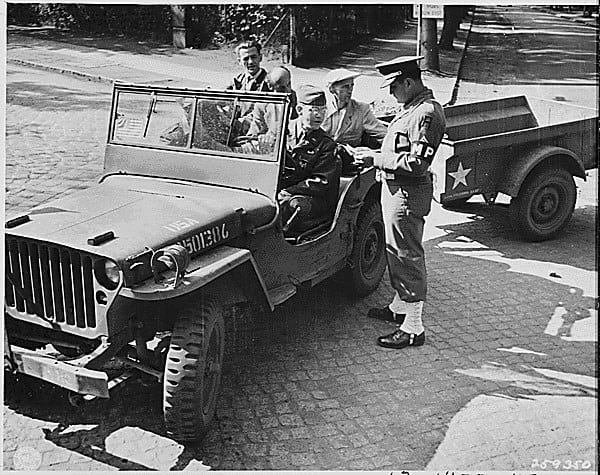American Bantam built 74,000 T3 trailers for WW2 military | HVA photos
From the Historic Vehicle Association, top 10 trivia about the “jeep,” the latest vehicle to be entered into the National Historic Vehicle Register.
- The Butler did it. The first 1/4-ton, four-wheel drive reconnaissance truck “pilot model” produced for the U.S. Army was built by the American Bantam Car Company of Butler, Pennsylvania.
- Consolation prize for Bantam. American Bantam is credited for development of the “jeep” concept but lost out on the big military contract for the standardized WWII “jeep.” What it got instead was the contract to produce the trailers for the “jeep.” During the war, American Bantam produced approximately 74,000 T3 trailers for the U.S. military.
The original Ford grille
- Grilled by Ford. One of the most distinctive elements of the “jeep” design was the flat slotted grill with integrated headlights, for which Ford gets the credit. Ford’s Pilot Model GP-No. 1 “Pygmy” featured a flat grille with integrated headlights. From 13 slots (1940), to nine slots (1941), to seven slots (1945) — that’s the history of the iconic “jeep” grille.
- The devil is in the details. The main reason Willys-Overland won the lion’s share of production for the WWII “jeep” was its engine. Willys-Overland began reworking its L134 engine in 1938 with the arrival of Barney Roos as the company’s new chief engineer. The result was the durable and powerful “Go-Devil” engine that became the heart of the “jeep” for decades.
- That’s what we’re talking ‘bout, Willis! In 1952, the Toledo Blade newspaper got to the bottom of the story and concluded that the jeep-producer’s corporate name should be pronounced “Willis.”
- Woodies for the masses. Prior to the war, woodie station wagons were expensive hand-crafted wood-paneled luxury vehicles but that would all change after the war, thanks to designer Brooks Stevens. Willys-Overland wanted its new product-line to leverage on the “jeep” success, and Stevens’ answer for the 1946 model year was the Willys-Overland, an all-steel, two-door, two-wheel drive “Station Wagon” with a “woodie-look.” It was a hit — finally, a woodie for the masses!
- Who’s your Daddy? It is said that “success has many fathers” and in the case of the “jeep,” the list of those who have claimed or are sometimes credited with “fathering the jeep” include: Col. William F. Lee (U.S. Army, Infantry); Charles Harry Payne, sales (American Bantam); Frank Fenn, president (American Bantam); Charles Probst, design engineer (American Bantam); Harold Crist, factory manager (American Bantam); Delmar “Barney” Roos, chief engineer (Willys-Overland). Where’s Maury Povich when we need him?
- Keep it Spicy! The unsung hero in the “jeep” story is the four-wheel-drive transfer case Model 18 produced by Spicer Manufacturing. This was a linchpin of the military jeeps and for decades of civilian jeeps thereafter. In 1946, Spicer changed its corporate name to Dana Corporation.
- The oldest jeep isn’t a Jeep? (It’s a Ford.) American Bantam delivered the first pilot model to the U.S. Army on September, 23, 1940. Willys-Overland delivered its pair of pilot model “Quads” to the Army on Nov. 11, 1940. Ford followed with GP-No. 1 and GP-No. 2 on November 23, 1940. Of these five pilot models produced, only the two Ford pilot models are known to survive, making the 1940 Ford Pilot Model GP-No. 1 “Pygmy” America’s oldest known “jeep.”
- They sold Grandpa? The Ford Pilot Model GP-No. 1 “Pygmy” was sold at auction by The Henry Ford Museum in 1982. At the time, museum staff might not have known it was the oldest surviving “jeep.” Today, the Henry Ford Museum displays a 1943 Willys-Overland Model MB and GP-No. 1 is on display and in good hands at the U.S. Veterans Memorial Museum in Huntsville, Alabama.
Advertisement for Henry Ford Museum sale






